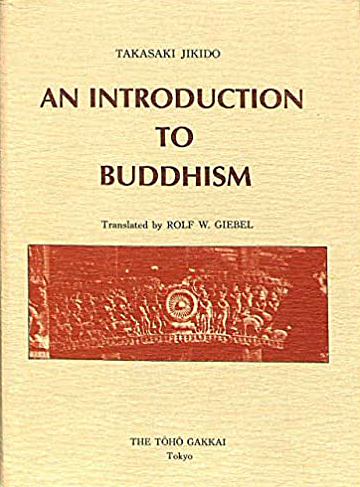- Preface to the English Versioniii
- A Note on Foreign Wordsviii
- Introduction: What is Buddhism?1
- Buddha, Dharma, and Saṃgha: The Three Constituents of Buddhism3
- Taking Refuge in the Three Treasures5
- The Absolute Nature of the Dharma8
- Mahāyāna and Hīnayāna: The "Greater" and "Lesser" Vehicles11
- The Buddhist Canon (tri-piṭaka)16
- I. The Life of Śākyamuni23
- The Buddha Śākyamuni23
- Biographies of the Buddha25
- Birth and Renunciation28
- Austerities and Enlightenment31
- The Beginnings of Śākyamuni's Teaching Ministry: His First Sermon34
- Dissemination of the Teaching and the Growth of the Community38
- The Great Decease42
- Erection of Stūpas and the First Council45
- II. The True Nature of the Buddha49
- Designations of the Buddha50
- Buddha and Tathāgata53
- The Former Lives of the Buddha55
- The Buddhas of the Three Ages59
- The Buddhas of the Ten Directions61
- Material Body and Dharma-Body64
- The Theory of Three Bodies68
- III. Dharma: The Buddhist Conception of Truth70
- The Meanings of Dharma70
- The Basis of the Teaching: Dependent Co-arising and the Four Noble
Truths76 - Śākyamuni's: Philosophical Position: The Ten or Fourteen Unanswerables85
- "Dharma-seals": The Watchwords of Buddhism89
- Saṃskāra and Dharma: The Dependently Co-arisen96
- Dharmatā: The Principle of Dependent Co-arising100
- The Conception· of Truth in Mahāyāna Buddhism104
- Supreme Truth and Conventional Truth105
- IV. Sarva-dharmāh: The Constituent Elements of Existence107
- The Classification of the Constituent Elements of Existence in the Early Canon: The Five Aggregates, Twelve Sense-Fields, and Eighteen Realms107
- The Sarvāstivādin Classification of the Constituent Elements of Existence:
The Five Categories and Seventy-five Elements114 - The Sarvāstivādin Theory of the Elements: The Elements Exist Eternally120
- The Mahāyānist Conception of the Elements: All is Empty126
- V. Transmigration, Karma, and Mental Defilements128
- Transmigratory Existence: The Three Realms and Six Paths128
- Karma137
- Mental Defilements141
- The Twelvefold Chain of Dependent Co-arising149
- VI. The Path to Enlightenment163
- Nirvāṇa and Enlightenment163
- The Mahāyānist Conception of Nirvāṇa168
- The Path to Enlightenment170
- The Noble Eightfold Path172
- The Three Disciplines: Morality, Meditation, and Wisdom174
- Faith and Practice188
- Practices for· the Welfare of Others191
- The Practices of the Bodhisattva: The Six Perfections193
- VII. Mind: The Agency of Practice198
- No-self and Subjective Agency198
- Mind (citta, manas, and vijñāna)200
- Mind-only and Cognition-only205
- The Innately Pure Mind and the Embryo of the Tathāgata215
- Enlightenment and Salvation223
- VIII. The Ideal Practitioner227
- The Concept "Man"227
- Ordinary Man and Holy Man228
- The Stages of the Bodhisattva233
- "One Vehide" and "Three Vehicles"240
- IX. The Precepts and the Organization of the Community246
- The Meaning of Saṃgha246
- The Organization of the Community250
- Community Regulations255
- X. The History of Buddhism263
- 1. Buddhism in India and the Surrounding Lands264
- The Basic Schism264
- The Mauryan Dynasty and Dissemination to Sri Lanka266
- The Kushan Dynasty and the Northern Tradition of Buddhism267
- The Characteristics of Schismatic Buddhism268
- The Birth of Mahāyāna Buddhism269
- The Mādhyamika and Yogācāra Schools270
- The Age of Esoteric Buddhism272
- Tibetan Buddhism275
- The Southern Tradition of Buddhism277
- The Revival of Buddhism in India278
- 2. Chinese Buddhism279
- The Introduction of Buddhism279
- Buddhism Takes Root: The Period of the Northern and Southern Dynasties280
- The Establishment of Chinese Buddhism: The Sui and T'ang Dynasties283
- Subsequent Developments290
- 3. Korean Buddhism290
- 4. Japanese Buddhism293
- The Introduction of Buddhism and Prince Shōtoku293
- The Sects of the Nara Period294
- The Tendai and Shingon Sects297
- The Rise of the Pure Land Teachings300
- The Introduction of the Zen Sects301
- The Nichiren and Ji Sects303
- Buddhism since the Muromachi Period305
- 1. Buddhism in India and the Surrounding Lands264
- Sources309
- Select Bibliography315
- General Index325
- Character Index352
- The Author; the Translator375

